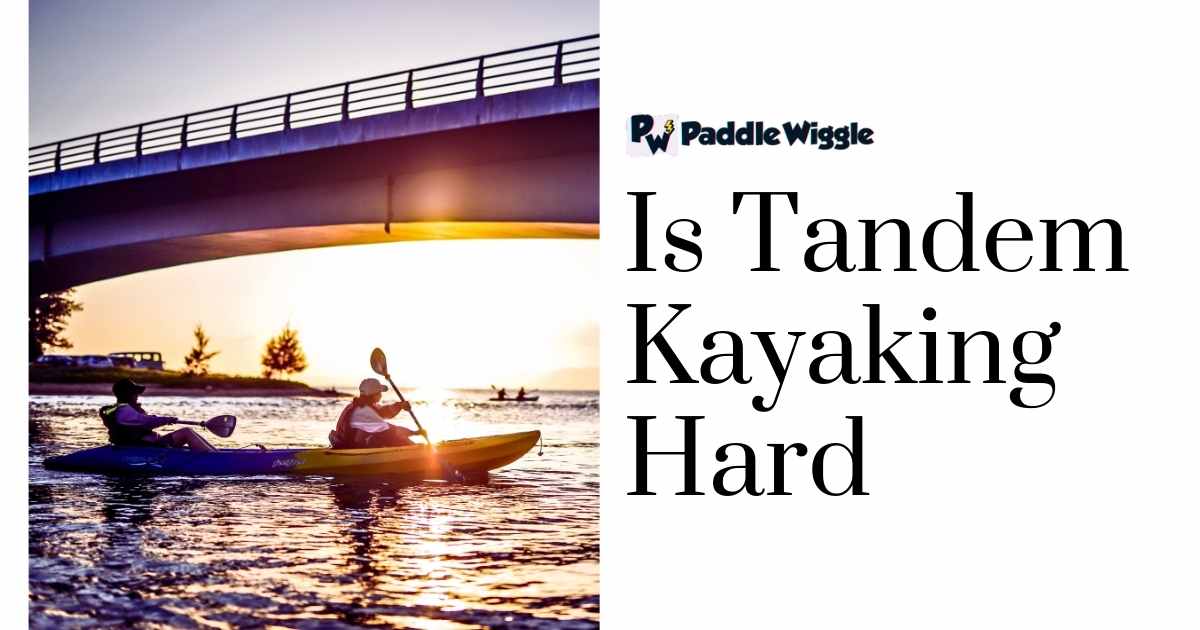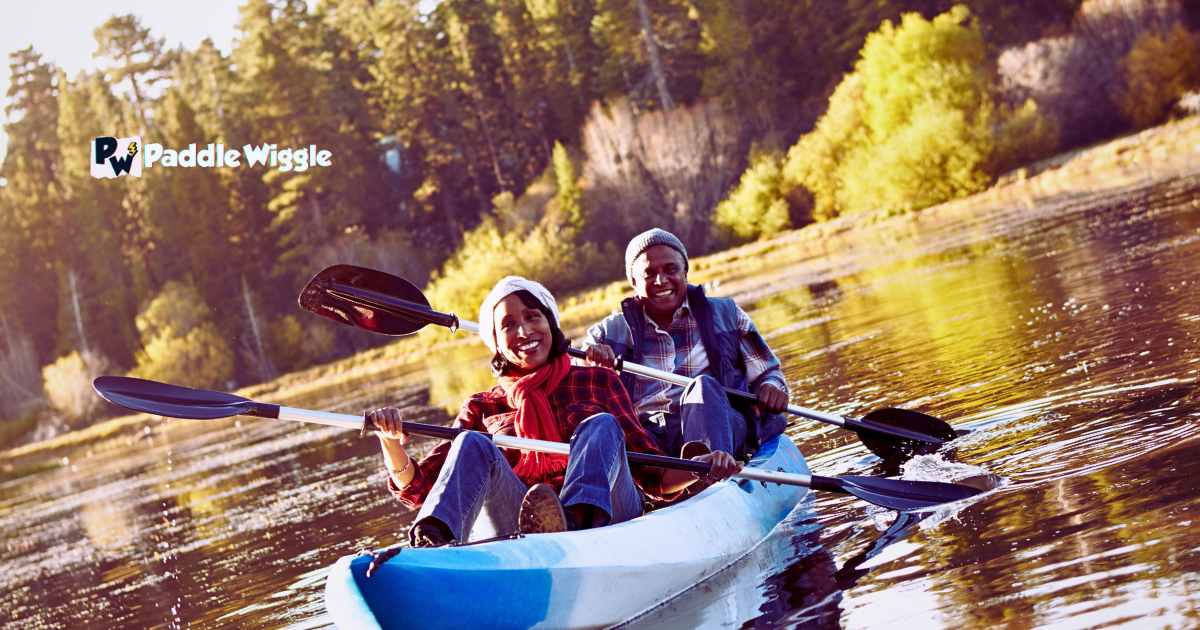Tandem kayaking, where two people paddle together in one kayak, can be an exciting experience. However, it requires good communication and coordination between both paddlers to navigate successfully. On the other hand, solo kayaking, where you paddle alone, offers more control and is often preferred by beginners.
So, is tandem kayaking difficult, or can anyone do it with some guidance?
In general, tandem kayaking is not overly difficult but can be a bit challenging, especially for beginners. It requires effective communication and coordination between the two paddlers. However, with practice and the right guidance, it becomes easier, and many people find it enjoyable. The level of difficulty depends on your kayaking experience, how well you communicate with your partner, and the type of water you’re kayaking in.
For those new to the sport, the idea of coordinating your movements with another person in a kayak might seem intimidating.
In this guide, we’ll demystify tandem kayaking, exploring its challenges and benefits and providing you with the knowledge and tips to make your tandem kayaking experience smooth and enjoyable. Let’s dive in and discover the world of tandem kayaking together.
Contents


How Difficult Kayaking Is In A Tandem Kayak
Tandem kayaking is like kayaking with a friend in the same boat. How hard or easy it is depends on how good you and your friend are at kayaking. If one of you is better, they can help the other. If you both talk and work well together, it can be a fun time for everyone.
However, highly experienced kayakers generally prefer solo kayaks for more control and maneuverability. For beginners, it’s important to start with manageable conditions and work on developing skills and teamwork over time.
Weak Kayaker with a Strong Partner
If you’re a weaker paddler paired with a strong partner in a tandem kayak, there are ways to make the experience easier:
- The stronger paddler should take the stern (rear) position in the tandem kayak. This provides better control and helps steer the kayak effectively.
- The weaker paddler can focus on maintaining a consistent paddle rhythm and supporting the effort of the stronger partner.
- With this setup, both people can have fun kayaking together, even if one of them could be stronger or more experienced.
Two Good Kayakers
Experienced kayakers often prefer solo kayaks because they offer more maneuverability and responsiveness. However, if two skilled individuals choose to paddle together in a tandem kayak:
- When you’re in a solo kayak, you can be in charge of your own journey. You can quickly make choices and change how you paddle to fit the situation.
- This independence is particularly advantageous when navigating through obstacles or catching waves.
Two Inexperienced Kayakers


For two inexperienced kayakers, tandem kayaking can present some challenges:
- It might be tough to work together if both kayakers aren’t used to talking to each other while they paddle.
- Maintaining a straight course requires teamwork and synchronization between both paddlers.
- Starting with easy trips in calm waters is recommended for beginners. As they gain experience, they can progress to more challenging environments.
In addition to these points, there are a few other factors to consider when it comes to the difficulty of tandem kayaking:
- Balancing the weight distribution in a tandem kayak can be challenging. Proper weight distribution is essential for stability and efficient paddling.
- Paddling in sync with your partner is crucial for efficient maneuvering. Communication and coordination are key to ensuring both paddlers are on the same page.
- Tandem kayaks may require more effort to paddle due to their larger size compared to solo kayaks.
Demystifying Tandem Kayaking: All You Need To Know


Tandem kayaking, or double kayaking, is a fun water activity where two people paddle together in one kayak. It’s a special way to enjoy exploring the waterways together.
Tandem Kayaks: Sharing the Adventure
Tandem kayaks are made for two people to paddle together smoothly. They’re longer and wider than kayaks for one person, so there’s room for both paddlers. When you use a tandem kayak, you can have fun outdoor adventures with your partner or friend and soak in the beauty of nature.
Communication is Key
Effective communication between both paddlers is essential. Navigating obstacles and changing directions requires coordination and teamwork. Talking clearly helps both paddlers know what to do, which makes it easier to steer the kayak smoothly.
Understanding the Basics
To make tandem kayaking easier, it’s essential to learn the basics of this activity. When you understand how tandem kayaks work and practice the right techniques, it will make your time on the water more enjoyable.
Here are some key factors that impact tandem kayaking:
- Experience and Skill Levels: How good you and your partner are at kayaking matters a lot when you’re kayaking together. If one of you is much better than the other, it can be tricky to paddle in sync and stay coordinated.
- Effective Communication: As mentioned earlier, communication is crucial when tandem kayaking. Both paddlers need to communicate their intentions clearly so that they can work together harmoniously.
- Choosing the Right Partner: Choosing the right person to paddle with is crucial for your tandem kayaking adventure. You should pick someone who is as excited and committed as you are to make sure you both get along well on the water.
- Decision-Making Process: When you’re tandem kayaking with a partner, you both decide together which way to go and how to get around things in the water. You work as a team to make these choices. This shared decision-making process requires trust and cooperation.
While tandem kayaking offers numerous advantages, it also comes with a few challenges:
- Shared experiences and memories
- Enhanced teamwork and communication skills
- Increased stability and control
- Potential disagreements or conflicts between paddlers
- Space constraints in the kayak, which may lead to discomfort
- The need for coordination and synchronization
The Power of Paddling Together in Tandem Kayaks
Paddling together in a tandem kayak can be an exhilarating experience. Not only does it allow you to enjoy the beauty of nature, but it also offers several advantages over paddling solo in a single kayak. Now, let’s look at why tandem kayaking is a good idea for your next adventure and the advantages it offers.
Increased Speed and Efficiency
Tandem kayaking is great because it’s faster and more efficient. When two people paddle together, their strength and teamwork make the kayak move faster. So, you can travel longer distances in a shorter time, which is perfect for long trips or races.
Better Navigation through Rough Waters
Navigating through rough waters or strong currents can be challenging when you’re alone in a single kayak. However, when paddling as a team in a tandem kayak, you have the advantage of better stability and control. By coordinating your strokes and adjusting your paddles accordingly, you can maneuver through challenging conditions with ease.
Reduced Fatigue during Long-Distance Trips
Long-distance kayaking can be physically demanding, especially if you’re paddling solo. But if you choose a tandem kayak, you can split the work with your partner, which makes you less tired. This way, both of you can rest while keeping a consistent speed during the trip.
Enhanced Communication and Bonding
Tandem kayaking requires effective communication between both paddlers to synchronize their movements effectively. As you paddle together through various water conditions, you’ll build trust and teamwork skills that are important for working well together. It’s not just about being strong; it’s also about forming a strong bond with your partner on the water.
Enjoyable Social Experience
Usually, kayaking is something people do alone, but tandem kayaking is different. It lets you hang out with a friend while you’re kayaking. You both have an adventure and make memories together. Whether you’re on calm lakes or wild rapids, tandem kayaking is a fun and social way to have a good time.
Harnessing Speed and Efficiency in Tandem Kayaking
When you’re kayaking with a partner, it’s really important to paddle at the same time and keep a steady rhythm. Doing it right, like using your body to twist, can make you go faster and be more efficient when you paddle together. Efficiently utilizing different paddle strokes helps navigate various water conditions.
Coordinating Strokes and Maintaining Rhythm
To go as fast as possible in a tandem kayak, it’s super important for both people to paddle together perfectly. Coordinating your strokes means making sure you put your paddle in and pull it out of the water at the same time as your partner. This coordination ensures that each stroke contributes to propelling the kayak forward.
Maintaining rhythm is equally important. If both people in the kayak paddle at the same time, it helps them go steadily through the water without wasting energy. When you keep a regular rhythm, you can keep moving without slowing down during your kayaking trip.
Proper Technique: Torso Rotation
One key aspect of proper technique in tandem kayaking is utilizing torso rotation. Instead of only using your arm muscles, turning your body while you paddle adds more strength to each stroke.
Think about turning your body from side to side as you paddle. This twisting action uses bigger muscles in your body, making your strokes more powerful. This increased power output translates into greater speed and efficiency on the water.
Efficient Use of Different Paddle Strokes
Depending on the water, you need to use different paddle strokes to stay in control and go as fast as possible. If you learn various techniques, you’ll be ready for whatever comes your way when you’re kayaking.
Here are some examples of paddle strokes commonly used in tandem kayaking:
- Forward Stroke: The basic stroke used for forward propulsion.
- Sweep Stroke: A wide arcing stroke used to turn or change direction.
- Draw Stroke: Pull the blade towards the kayak’s hull to move sideways or towards an object.
- J Stroke: Combining a forward stroke with a slight correction at the end to maintain a straight course.
By efficiently using these different paddle strokes, you and your partner can adapt to changing water conditions, such as currents or wind, while maintaining speed and control.
Exploring the Pros and Cons of Tandem Kayaks
Tandem kayaking can be a thrilling adventure, but is it hard? Let’s dive into the pros and cons of tandem kayaks to find out.
Shared Experience
One of the biggest advantages of tandem kayaking is the shared experience. Instead of going solo, you have a partner to enjoy the journey with. It can be a great bonding activity for friends or family members. Imagine paddling together, exploring beautiful waterways, and creating lasting memories.
Increased Stability
Another pro of tandem kayaks is their increased stability compared to solo kayaks. With two people in one boat, there is better balance and less chance of tipping over. This stability can give beginners more confidence on the water and make them feel safer during their kayaking adventure.
Potential for Stronger Paddling Power
Tandems have an advantage. When two people paddle together, they create more power and speed than one person alone. This allows you to travel further in a shorter time, which is great for long trips or races.
Potential Disagreements Over Steering
However, there are some downsides to consider as well. One potential con is disagreements over steering. When you have two people steering the kayak, you might sometimes have differing views on which way to go or how to get past obstacles. To avoid arguments while on the water, it’s crucial to talk well and work together as a team.
Limited Individual Control
In tandem kayaking, you have limited individual control compared to solo kayaking. It would help if you had coordination with your partner for every maneuver you make on the water. Working together helps you get better at teamwork, but it also means you can only sometimes go where you want or paddle as fast as you’d like.
Longer Decision-Making Process
Making decisions while tandem kayaking may take longer compared to kayaking solo. When two people are involved, there might be more talking and thinking before you both agree on which way to go or what to do in certain situations. This can make it take longer to decide and could slow down your adventure.
5 Tips For Making the Most of Tandem Kayaking
Tandem kayaking can be a fun and exciting activity to enjoy with a partner or friend. However, it’s important to know a few tips and tricks to make the most of your tandem kayaking experience. Here are five tips to help you make the most of your tandem kayaking experience.
Tip #1. Establish clear communication signals with your partner.
Communication is key. Before you begin kayaking, set up clear signs with your partner to talk well on the water. You can use easy signals like tapping the kayak or hand signals to send messages without yelling over the noise of the waves.
Tip #2. Practice together in calm waters before tackling challenging conditions
To build trust and coordination, it’s essential to practice paddling together in calm waters first. Find a quiet lake or river where you can focus on getting in sync with each other’s paddle strokes. This will give you both a chance to get comfortable working as a team before taking on more challenging conditions.
Tip #3. Adjust seating positions to optimize weight distribution and balance
It’s really important to sit in the right way to stay stable in a tandem kayak. Try different ways to sit until you both feel comfortable. Keep in mind that how you both sit and distribute your weight can affect how smoothly the kayak moves in the water.
Tip #4. Coordinate paddle strokes and maintain a consistent rhythm
Paddling in unison is vital for efficient movement through the water. When you paddle, make sure to start at the same time and keep a steady rhythm all the way. Doing this will stop you from moving in zigzags or hitting things in the water by accident.
Tip #5. Be patient and understand your partner
Lastly, remember that tandem kayaking requires teamwork, patience, and understanding between partners. It may take some time to get into sync and adapt to each other’s paddling style. Embrace the learning process and focus on enjoying the experience together. By being patient and supportive, you can enhance your overall tandem kayaking adventure.
Whether you’re kayaking on calm lakes or challenging rapids, these tips will help you paddle smoothly with your partner. Remember to talk well, practice in calm waters, sit right for balance, paddle together, and be patient with each other. With these tips in mind, you’ll be well on your way to making the most of your tandem kayaking experience!
Final Words
Tandem kayaking might seem a bit challenging at first, but with practice and teamwork, it becomes an enjoyable experience. When you paddle together in sync, you can use the combined strength of two people to achieve your goal.
Learning tandem kayaking just takes a few practice sessions. But once you get the hang of it, you’ll have fantastic moments gliding smoothly on the water with your partner.
So, if you’re up for a challenge and excited about exploring new adventures with a companion, tandem kayaking is definitely worth a try.



